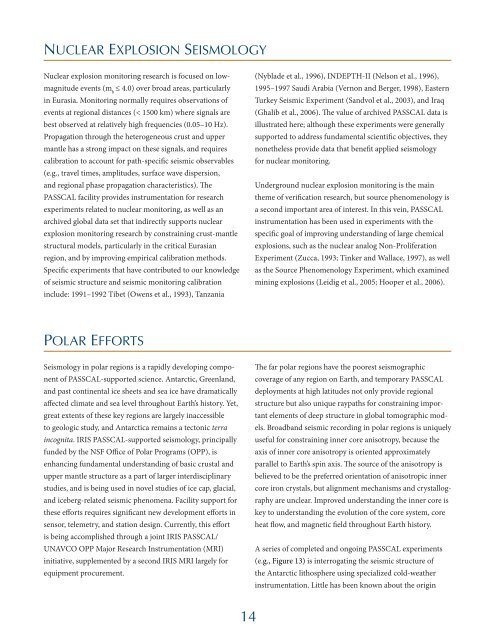Download 9.3 Mb pdf - IRIS
Download 9.3 Mb pdf - IRIS
Download 9.3 Mb pdf - IRIS
Create successful ePaper yourself
Turn your PDF publications into a flip-book with our unique Google optimized e-Paper software.
Nuclear Explosion Seismology<br />
Nuclear explosion monitoring research is focused on lowmagnitude<br />
events (m b<br />
≤ 4.0) over broad areas, particularly<br />
in Eurasia. Monitoring normally requires observations of<br />
events at regional distances (< 1500 km) where signals are<br />
best observed at relatively high frequencies (0.05–10 Hz).<br />
Propagation through the heterogeneous crust and upper<br />
mantle has a strong impact on these signals, and requires<br />
calibration to account for path-specific seismic observables<br />
(e.g., travel times, amplitudes, surface wave dispersion,<br />
and regional phase propagation characteristics). The<br />
PASSCAL facility provides instrumentation for research<br />
experiments related to nuclear monitoring, as well as an<br />
archived global data set that indirectly supports nuclear<br />
explosion monitoring research by constraining crust-mantle<br />
structural models, particularly in the critical Eurasian<br />
region, and by improving empirical calibration methods.<br />
Specific experiments that have contributed to our knowledge<br />
of seismic structure and seismic monitoring calibration<br />
include: 1991–1992 Tibet (Owens et al., 1993), Tanzania<br />
(Nyblade et al., 1996), INDEPTH-II (Nelson et al., 1996),<br />
1995–1997 Saudi Arabia (Vernon and Berger, 1998), Eastern<br />
Turkey Seismic Experiment (Sandvol et al., 2003), and Iraq<br />
(Ghalib et al., 2006). The value of archived PASSCAL data is<br />
illustrated here; although these experiments were generally<br />
supported to address fundamental scientific objectives, they<br />
nonetheless provide data that benefit applied seismology<br />
for nuclear monitoring.<br />
Underground nuclear explosion monitoring is the main<br />
theme of verification research, but source phenomenology is<br />
a second important area of interest. In this vein, PASSCAL<br />
instrumentation has been used in experiments with the<br />
specific goal of improving understanding of large chemical<br />
explosions, such as the nuclear analog Non-Proliferation<br />
Experiment (Zucca, 1993; Tinker and Wallace, 1997), as well<br />
as the Source Phenomenology Experiment, which examined<br />
mining explosions (Leidig et al., 2005; Hooper et al., 2006).<br />
Polar Efforts<br />
Seismology in polar regions is a rapidly developing component<br />
of PASSCAL-supported science. Antarctic, Greenland,<br />
and past continental ice sheets and sea ice have dramatically<br />
affected climate and sea level throughout Earth’s history. Yet,<br />
great extents of these key regions are largely inaccessible<br />
to geologic study, and Antarctica remains a tectonic terra<br />
incognita. <strong>IRIS</strong> PASSCAL-supported seismology, principally<br />
funded by the NSF Office of Polar Programs (OPP), is<br />
enhancing fundamental understanding of basic crustal and<br />
upper mantle structure as a part of larger interdisciplinary<br />
studies, and is being used in novel studies of ice cap, glacial,<br />
and iceberg-related seismic phenomena. Facility support for<br />
these efforts requires significant new development efforts in<br />
sensor, telemetry, and station design. Currently, this effort<br />
is being accomplished through a joint <strong>IRIS</strong> PASSCAL/<br />
UNAVCO OPP Major Research Instrumentation (MRI)<br />
initiative, supplemented by a second <strong>IRIS</strong> MRI largely for<br />
equipment procurement.<br />
The far polar regions have the poorest seismographic<br />
coverage of any region on Earth, and temporary PASSCAL<br />
deployments at high latitudes not only provide regional<br />
structure but also unique raypaths for constraining important<br />
elements of deep structure in global tomographic models.<br />
Broadband seismic recording in polar regions is uniquely<br />
useful for constraining inner core anisotropy, because the<br />
axis of inner core anisotropy is oriented approximately<br />
parallel to Earth’s spin axis. The source of the anisotropy is<br />
believed to be the preferred orientation of anisotropic inner<br />
core iron crystals, but alignment mechanisms and crystallography<br />
are unclear. Improved understanding the inner core is<br />
key to understanding the evolution of the core system, core<br />
heat flow, and magnetic field throughout Earth history.<br />
A series of completed and ongoing PASSCAL experiments<br />
(e.g., Figure 13) is interrogating the seismic structure of<br />
the Antarctic lithosphere using specialized cold-weather<br />
instrumentation. Little has been known about the origin<br />
14

















